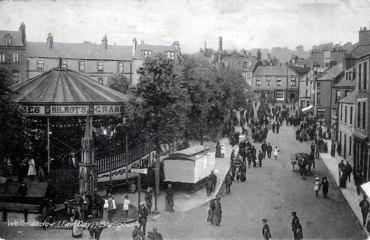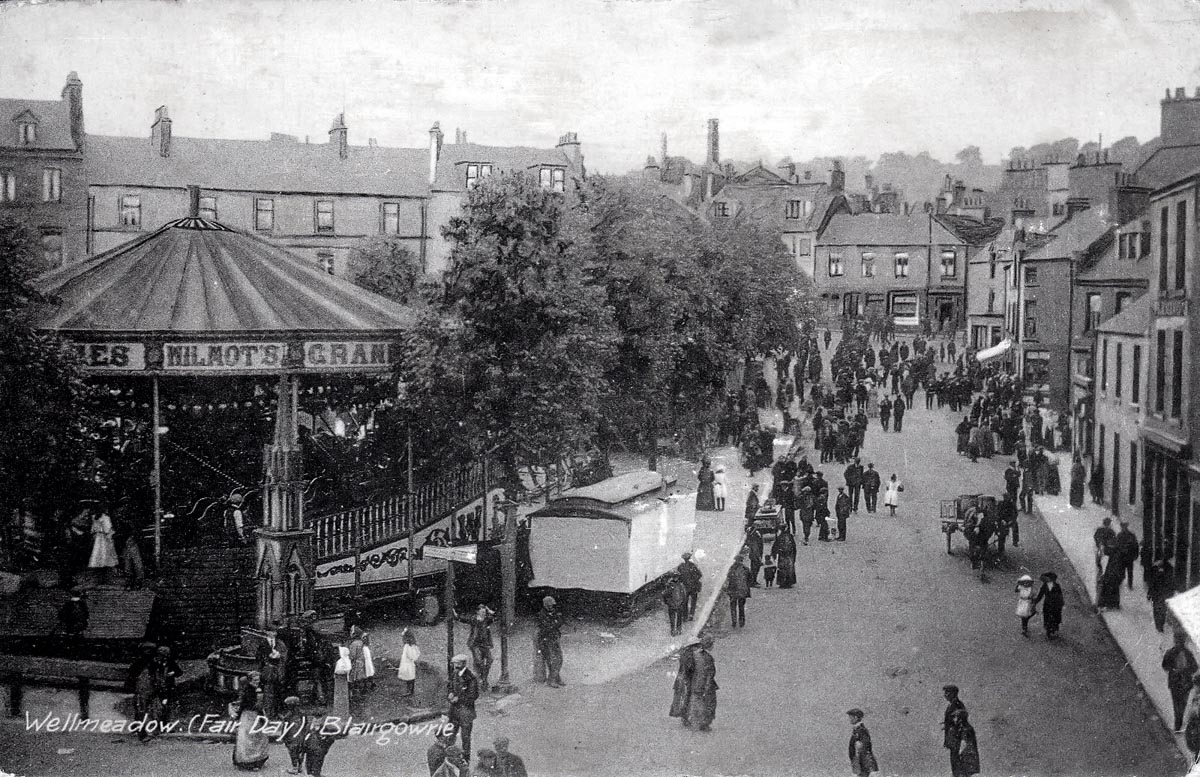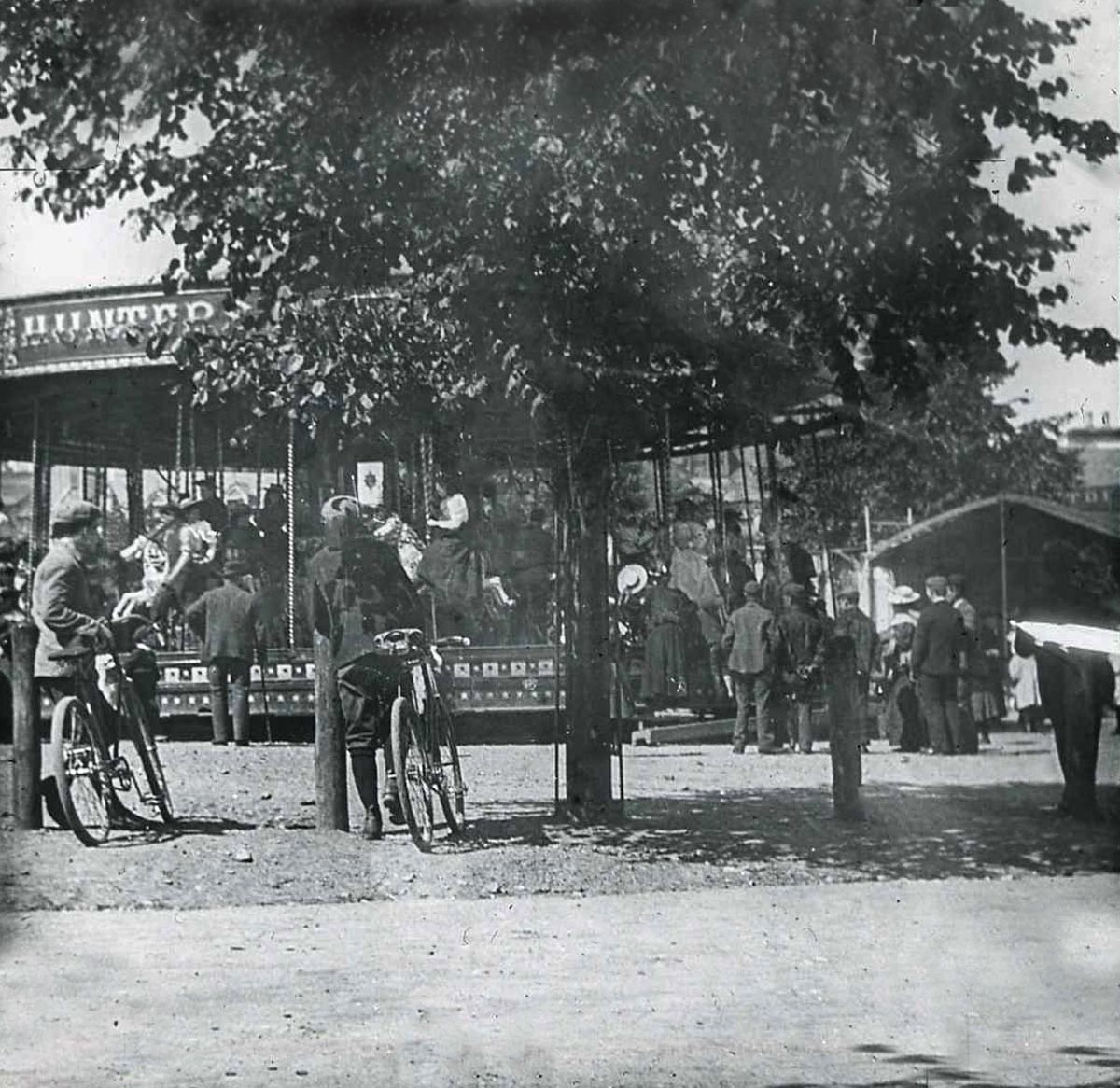Our Heritage Timeline
Markets and Fairs

Markets and Fairs
Shop 'til you drop!
The earliest reference to markets and fairs in the Parish of Blairgowrie may be found in the 1796 Statistical Account in which Rev.James Johnstone writes: "There are three fairs held annually and some attempts have been made to have a weekly market, but with little success".

Following the 1707 Act of Union, the growth in demand from England for cattle raised in the Highland glens led to the establishment of the cattle markets at Crieff and Falkirk. Drovers on their way to these markets needed grassy areas in which to rest, graze and water their cattle and sheep. The Wellmeadow in Blairgowrie provided that.
The Wellmeadow became the venue for one of the leading livestock markets in the area. As well as cattle, sheep, wool and grain were also bought and sold.
Advertisements like this one in November 1833 in the Perthshire Advertiser would appear in newspapers:
BLAIRGOWRIE MARKETS
for the
SALE OF CATTLE AND GRAIN
shall in future be held on SATURDAY, FORTNIGHTLY,
or each alternate Saturday, commencing on Saturday
the 7th day of December next, and continuing till the
latter end of May.
The market will be held as formerly, on the Wellmeadow
and no Custom will be charged.
Blairgowrie, 4th November, 1833.
By 1845 Wednesday had become the day for fairs and markets as recorded by Rev. Robert McDonald in the Statistical Account for the Parish of Blairgowrie:
"The fairs held in the town are the following, viz. the third Wednesday in March; the 26th of May (if a Wednesday, if not the first Wednesday after); the 23rd July; the first Wednesday in November; the 22nd November (or first Tuesday thereafter); and on the Wednesday before the Falkirk Tryst. A market for cattle and grain is also held, every fortnight, on Wednesdays, during the winter and spring, which is much frequented by the farmers and graziers of the district".
The Loyal Order of Ancient Shepherds (Lodge Tullyveolan) was instituted in Blairgowrie in 1884 and in 1887 they revived the Highland Games which had been allowed to lapse. The Highland Games would be arranged to take place on the same day as the Fair O' Blair.
The Fair O' Blair was also a Feeing Market, a form of employment fair common in Scotland especially in agricultural areas. The feeing market was traditionally where farmers could recruit dairymaids, ploughmen, cattlemen and other domestic servants.

The Dundee Courier on Tuesday 19 July 1898 published this description of a Feeing Market and Fair. The venue is not named, but it is easy to imagine that this describes the sights, sounds and smells of the Wellmeadow on Fair O' Blair day.
A FEEING MARKET
ALL THE FUN OF THE FAIR
ROUND THE SIDE SHOWS
At the present day we must regard the term 'feeing market' as somewhat of a misnomer, for it cannot strictly be called a market since the auction sales have knocked the selling of cattle by means of trysts on the head. There is little or no buying and selling at the average fair of today, if we except such temporary necessities as sweeties, gingerbread, ice-cream, and the like. Farmers may still take the opportunity of doing a little private business with their neighbours or friends after they have engaged their servants, or a local agent may push the sale of some new farm implement or cater for the sale of manures and feeding stuffs. But this is all; no cattle are exposed unless in very exceptional circumstances. However, we may leave aside such discussions, and take a stroll around this north country feeing fair that we may see the shows and merry-go-rounds, the strolling musicians, and the ever present beggars.
It is astonishing to find that many of the amusements provided twenty or even thirty years ago are still as popular as ever. The swing-boats, shooting galleries and leaping horses have not suffered in the least from the appearance of the phonograph and cinematograph, for each class of amusement or entertainment appeals to its own class of audience. There is always a growing variety in the shape of the "three-balls-a-penny" type, and all seem to flourish. Many visitors would appear to consider that they are out for a holiday, and may as well enjoy all the fun of the fair as part of it, no matter how many peep-shows there are to be seen nor how many phonographs there are to be patronised.
The square of the little village is crowded, for it is in it that the feeling goes on. We leave it, and wander slowly along the road to the market hill where the general jollity of the afternoon goes merrily along. Those servants who have already made an engagement are making their way up to the hill, while others may be making their way back again after having a foretaste of what the afternoon will provide for their amusement. It is a case of strolling backwards and forwards, until after mid-day, when the square will be practically deserted. Along the roadside are dotted here and there at convenient corners sweetie or fruit stalls. Here is an Irishman delighting a crowd of youths with his drolleries and extravagant fun. He is dressed in real Irish garb, sings real Irish songs, but whether he is a real Irishman himself is open to doubt. Likely as not he is some broken-down music hall comic singer. Then may be seen a blind man who sits meekly at the roadside holding a tin jug before him. He says nothing, but a card upon his breast tells that he lost his sight by typhoid fever. A shy little girl stands near him; she is his guide, and for a long time he has every half-year occupied the same spot, and in good weather usually seems to thrive. Further along we pass a ragged woman who is trying to open the purses of passers-by with a rendering of "Cam ye by Atholl?" We may also be certain that her husband is also in the market in some capacity or other. As we turn from the road towards the hill we find a young man dressed in naval rig-out. He holds out his cap in his left hand, for his right arm is gone, and he keeps requesting the passers to remember a man-of-war's man who lost his limb in action. At intervals he would place the cap upon the ground, pocket the few pennies it held then resume his position of "attention" again. But now we are into the crowd, and alms-seekers would here have no chance, for all is bustle, jostle, jumble, tumble and general rollicking about. "Three balls a penny", shouts the keeper of a dolly stall. "Cigar every doll you tumble". And since the dolls are no more than a thin wire dressed out with much wool it may be concluded that he does not give away many cigars. Next comes the "nice and juicy", "fresh and milky" coconut man, who will give you a nut for every large ball you throw into one of the small barrels he has arranged in three rows before you. "Try your strength, gentlemen," shouts a man at your ear, and many young men may be seen vying with each other as to who can lift the most. "Thirty-seven stone," shouts the owner of the instrument, and soon his crowd of patronisers swells considerably. A galvanic battery next invites attention, and it seems to be well patronised, as is also a "lung-tester," which, by rather questionable means, tells you if your lungs are in a good, bad, or indifferent way. It does tell, however, if you can, after a full inspiration, send the pointer farther round than your neighbour, and that is all that is necessary to make it popular in a country fair. Here is a woman with birds that tell fortunes, and you may buy a dozen different ones if you like and then take your choice. It is amusing to watch the young people reading what is drawn for them, and then blushing at their good luck and stowing away the precious paper for future reference and possibly with the intention of preserving it all their lives.
We now turn to the right and ascend the slope where are arranged the refreshment tents and a long line of stalls that will sell anything in the fruit and sweetie line, toys, novelties, and such indestructible goods generally. "Sold again," comes a loud voice, "the best pennyworth in Scotland." "This way for the bargains," answers a near rival, "the biggest pennyworth in the world. Sold again." And so on the pleasant rivalry goes. "Try a shot, sir?" asks a young lady at one of the shooting galleries. Many, of course, do try, and when the bell has been rung by anyone the rivalry that gets up among the onlookers soon swells the drawings of the gallery owner. The shooting saloons with glass balls tottering on a jet of water, or with any amount of breakable material in the far end, seems also to do a good trade, but the things that seem to attract the most attention are the swing-boats, for these are always full. The jumping horses driven by hand and the gallopers driven by steam do a roaring trade. In the case of the latter, posing is a necessity, and much amusement is provided to the onlookers by the futile efforts of some youths to look as if they really enjoyed it while they are being whirled round dragoon fashion.
To a certain class the Boxing tent is a great attraction. There are three boxers, and after exhibiting their own skill, they invite any two from the audience to enter the ring and show theirs. An instant response to this is generally made, and so the boxing goes on steadily, since there is a fresh audience every ten minutes or so. The phonograph is always a popular thing, and will be kept fairly busy all day. Picture panoramas and shows of a similar nature are not nearly so well looked after; something with plenty of frolic and boisterousness is needed for a Fair.
It is very difficult to understand wherein lies the fascination for dancing a Highland Schottische on ground that is very rough and uneven. Yet we have here a number of young men and women who have organised a dance, and have prevailed upon one of the wandering players to supply the music. The concertina is squeezing out the notes of the "Braes o' Mar," and the dancers are hooching and shouting to their heart's content. We would readily pass their innocent frolic, but we cannot forgive them for overtreating the poor concertinaist, who possesses a certain weakness, and whom they leave incapable of doing much beyond getting fast asleep behind one of the tents! Another wanderer is cheerily grinding on with an old "French fiddle," which unhappily has lost some of its keys, and so makes many slips, but he smiles and jerks away, and never heeds the deficiency; it is pence that he is after. Further along an old white-haired cripple hops about with a fiddle, and endeavours to delight his hearers with some one of three or four tunes which change their names every now and again in a most wonderful manner. His playing is quite as poor as his selection of tunes, but he is a new hand at the work, and may yet improve.
But we have seen the best at least of the fun of the Fair, and may fitly draw to a close. As evening is drawing on the people begin to pull down and pack up their tents, stands, swings, or shows. The scene of commotion and jollity of two hours before gives place to one of work and bustle, and gradually all who do not intend to stay overnight on the ground draw off. The fun of the Fair may be carried on next morning by the village boys looking for lost pence or pocket-knives, but in a day or two the market hill assumes its ordinary aspect, to be visited again by a merry-making crowd six months later".
The organisers of the Fair O' Blair brought many memorable events to Blairgowrie and none more so than in 1903 when the Dundee Evening Telegraph on Wednesday 29 July 1903 reported:
SCENES AT THE FAIR O' BLAIR
Yesterday was notable for two outstanding features: 1) the balloon ascent and parachute descent at the games 2) the revival of the Fair O' Blair.
Dealing with the former, it was novel, and daring, and thrilling, and above all, attractive, but many in the crowd were hardly in love with it, to say the least, and felt relieved when Miss Maud Brookes, 'England's Parachute Queen', alighted on terra firma once more in safety.
The whole business of getting the balloon up was very interesting. Few had seen, and probably as few understand the modus operandi adopted on such occasions. In the first place, the balloon was a huge affair of some 70000 cubic feet capacity, to inflate which with hot air required special apparatus. This consisted, first, of a couple of high poles, between which the balloon was suspended in a collapsed condition.
From the top of the poles was a rope, which was threaded so to speak, through a pulley or eyelet outside the top of the balloon, and by means of this the gas bag was raised clear of the heating apparatus inside, for fear of fire, till there was sufficient hot air to lift the balloon.
The heating arrangements consisted of: 1) a deep trench in the soil, used as a sort of fireplace 2) an underground 'flue' of perhaps 12 feet, connected to 3) a chimney built of bricks and about 4 feet high. Plenty of wood was fed into the fire at 1); a splendid draught sent the heated smoke and air along a flue and out at the chimney into the interior of the balloon, which was held close to the ground by a score or more willing volunteers.
As the spheroid expanded and ready to rise - indicated by a suspended bag of sand being raised from the ground - the lady of the parachute emerged from the tent; the parachute was spread out flat upon the ground, and taking the trapeze in her hands, she stood awaiting the dictates of fate.
The word was passed round - 'Ready!' Then the command - 'Let go all!' and in a moment the inflated balloon rose in the air, the long folded parachute, with dangling human appendage, swinging into graceful position. Just how high the daring parachutist ascended it is not easy to determine; quite high enough to hurt her should anything have gone wrong with the apparatus.
Fortunately, Maud Brooks descended safely at Cleekerinn Park on 28 July 1903. Her younger sister Edith Brooks died on 20 May 1902 aged 23, when her parachute failed to open during a display at Sheffield Wednesday Football Ground.
Item No.2 - The Wellmeadow - was much more interesting. Considering that, owing to the ukase issued by the Town Council - since revoked - nothing whatever in the shape of booth, show, or other entertainment was permissible on the Meadow last year, and the time honoured Fair O' Blair was, apparently, as dead as the proverbial door nail - considering all this, a sight of the life and activity on the Meadow last night was sufficient to excite emotions. The particular emotion depended upon the individual's point of view. There are about 50 booths etc, arranged about this popular centre, and it is really astonishing how smartly the revival has been accomplished. From the looks and language of the people it is evident that all were delighted with the change; and an observant looker-on might almost have concluded that some of the ploughmen and others blattering away at Aunt Sally or hideous giant heads with pipes for teeth, were from their eagerness, trying to make up for the deadly dull times they had to submit to last July. There is nothing better for a study of human nature than a fair and that going on at present in the centre of Blair is no exception. Here's a booth-woman quarrelling with a ploughman because he wants a pair of flower vases, instead of one, for his feat in knocking a pipe down the throat of one of the giant heads aforesaid. There's a fellow who has lost some coppers at the suspended ball and cone booth interfering with the business of the man out of revenge. A grand stand, with a tempting display of clocks, watches, vases etc. is a great attraction to the youth of the city, who get ten rings for 2d, and are required only to ring any of the knobs from which each article is suspended to get the article itself. How easy to look at! How difficult to do!
One young fellow has spent, one would say, a couple of shillings trying to ring a nice looking watch and albert. At last! The ring is half on the knob. A dispute imminent; ring not quite on. The stall-keeper generous, however, takes down the article, and hands it over, with the explanatory (and eye opening remark), 'There you are! Of course, you know, it ain't a watch, but only a watch box!' Which it was. The language of that young man would need a special font of type for itself.
There's another tastefully got-up stall, with lovely little lamps alit all over it - almost like Aladdin's wonderful garden. One has only to drop a penny into the proper slot to get a warranted and copyrighted likeness of one's future husband or wife, as the case may be. It is such an easy and delightful, not to add, cheap method that good business is apparently being done. Forward comes a reporter with notebook in hand. What he is writing is of no account, but the man eyes him and his notes suspiciously. 'What do you call them 'ere marks in your book?' asks he. To which the polite pressman - 'Shorthand. Hope you have been doing good business recently'. 'More weather than business' is the gruff reply. Then returning to the charge - 'An' wot them 'ere short and marks signify, may I ask?' 'Words, my dear sir,' answers the notetaker, 'Only words, I assure you,' and passes on. One thing, at any rate, is certain, the revival of the Fair O' Blair is a popular event, and seems likely to become permanent.
MARKETS AND FAIRS NOWADAYS
As set out in the conditions when the Wellmeadow was gifted to the town, regular markets still take place in the Wellmeadow.
BLAIRGOWRIE FARMERS & PRODUCERS MARKET
This runs on the last Saturday of the month, with local producers offering a variety of fresh seasonal produce.
Visit:
https://www.facebook.com/people/Blairgowrie-Farmers-and-Producers-Market/100092334855348/
CHRISTMAS LIGHTS SWITCH ON AND MARKET
Each year Blairgowrie and Rattray Christmas lights are nothing short of magical thanks to a hard working group of volunteers. Fund raising events such as Santa's Sleigh Ride provide for the maintenance and purchase of lights. The lights are erected ready for the Switch On ceremony which takes place in the Wellmeadow in late November. The Switch On is combined with entertainment and a Christmas Market. Visit
https://facebook.com/bandrchristmaslights/
BRAEMAR NIGHT
This popular annual event started off in a very small way with music being played in the Wellmeadow to encourage those travelling back from the Braemar Gathering (held on the 1st Saturday in September since 1917) to stop off in Blairgowrie. Over the years other forms of entertainment like Highland dancing and live bands were added. Since 1975 a hard-working and enthusiastic group of volunteers has been able to organise a full and varied programme of entertainment.
https://www.facebook.com/events/blairgowrie-braemar-night/285748688217484/
Previous Page
